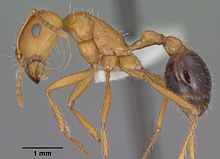| Pogonomyrmex californicus | |
|---|---|

| |
| P. californicus worker from Arizona | |
| Scientific classification | |
| Domain: | Eukaryota |
| Kingdom: | Animalia |
| Phylum: | Arthropoda |
| Class: | Insecta |
| Order: | Hymenoptera |
| Family: | Formicidae |
| Subfamily: | Myrmicinae |
| Genus: | Pogonomyrmex |
| Species: | P. californicus |
| Binomial name | |
| Pogonomyrmex californicus Cole, 1968 | |
Pogonomyrmex californicus, or California harvester ant, is a species of ant in the subfamily Myrmicinae. It is native to North America, where it occurs in the southwestern United States and northern Mexico. It is best known as the ant that is sent out for Uncle Milton's Ant Farm.
Biology
Pogonomyrmex californicus can be found in open, warm, and sandy areas. Typically, it forages during the day as individuals or in a group, forming columns as they work. It preys on arthropods, such as the larvae of the raisin moth (Cadra figulilella) and collects seeds. It can form colonies of hundreds of individuals. The nest entrances are often irregular and are surrounded by loose sand arranged in a circular or semi-circular pattern. Reproduction occurs around July, when reproducing individuals are present.
Polygynous colonies
Pogonomyrmex californicus forms multiple-queen colonies at times. Most colonies are founded and sustained by one queen, but one population has been noted to contain multiple queens in a cooperative, a phenomenon known as pleometrosis.
Range
The distribution of this ant extends from Texas to Utah to Baja California, Sonora, and Chihuahua.
Chumash use as hallucinogen
The Chumash people of California would sometimes use the species as an entheogen with which to initiate boys into manhood. The consumption of these ants was considered a safer method of inducing visions than the more usual method employed which involved the drinking of a brew prepared from the deliriant herb Datura wrightii. The ants were swallowed alive on eagle down and the venom injected in the stings that they inflicted on the mouths and throats of the boys would cause them to hallucinate. Around 250 ants constituted an effective dose.
References
- A Dictionary of Entomology. CABI. 2011. p. 244. ISBN 978-1-84593-542-9.
- ^ Lubertazzi, D.; G. Alpert (2010). "Pogonomyrmex californicus Buckley". Navajonature.org. Retrieved 31 January 2011.
- Hevesi, D. (January 29, 2011). "Milton M. Levine, 97, Inventor of Ant Farm, Dies". The New York Times. Retrieved 31 January 2011.
- Adams, J. D. Jr.; Garcia, C. (2005). "Spirit, Mind and Body in Chumash Healing". Evidence-Based Complementary and Alternative Medicine. 2 (4): 459–463. doi:10.1093/ecam/neh130. PMC 1297503. PMID 16322802.
External links
 Media related to Pogonomyrmex californicus at Wikimedia Commons
Media related to Pogonomyrmex californicus at Wikimedia Commons
| Taxon identifiers | |
|---|---|
| Pogonomyrmex californicus | |